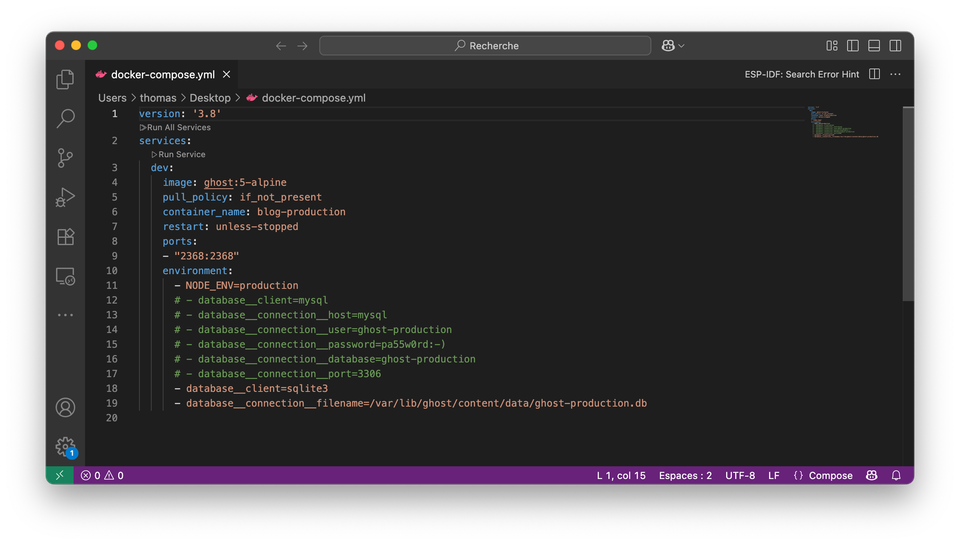Ghost CMS: MySQL by default, but SQLite still has a place

Last reviewed: Aug 2025
Ghost’s v5.x series made MySQL 8 the officially supported database in production. The change gives the core team one stack to maintain and unlocks features that depend on MySQL-specific functions. Yet the single-file convenience of SQLite is still attractive for certain workloads, especially when you run Ghost inside Docker or on low-resource hardware. This guide explains when SQLite may be the better fit and how to switch without drama.
Why Ghost Uses MySQL Now
| Reason | Benefit you gain with MySQL |
|---|---|
| JSON columns and very large tables | Native JSON type and higher size limits |
| Better concurrency | Multiple writers without global locks |
| Future roadmap | Upcoming analytics and reporting features rely on MySQL functions |
Ghost ships just one “blessed” stack (Ubuntu + Node LTS + MySQL 8) to keep support overhead low.
Where SQLite Still Shines
| Scenario | Why SQLite helps |
|---|---|
| Single-author or low-traffic blogs | Zero administration, no separate server process |
| Budget VPS or Raspberry Pi | Far lower RAM and CPU usage than mysqld |
| Simple backups | The whole site lives in one .db file |
| Air-gapped or USB deployments | Database can sit on removable media |
| Docker deployments with SQLite | The database file remains inside the container volume, so you spin up everything with a single docker compose up |
Important note: SQLite allows many readers but only one writer at a time. Busy multi-author sites can hit write-lock contention.
Quick Pros and Cons
| SQLite | MySQL 8 | |
|---|---|---|
| Install footprint | One 700 kB binary | Full server (~500 MB) plus a running service |
| Backups | Copy one file or use the hot-backup API | mysqldump, replication or physical snapshots |
| Concurrency | One writer (WAL mode helps) | Many concurrent writers and readers |
| Ghost support | Community best-effort | Officially supported |
| Upgrading Ghost | No database tweaks needed | Must track MySQL major versions |
Switching From MySQL to SQLite
Ghost does not officially QA SQLite in production. Use it only if you accept that trade-off.
- Export content from the running MySQL blog
Admin area → Settings → Labs → Export content
This downloads aghost-export.jsonfile to your computer. - Start the new blog and import the JSON
Admin area → Settings → Labs → Import content → selectghost-export.json
Check the post count
sqlite3 content/data/ghost.db "select count(*) from posts;"
If the number matches your old site, the migration is done.
Spin up a fresh Ghost instance that points to SQLite
Docker example (compose file excerpt)
services:
ghost:
image: ghost:5-alpine
volumes:
- ./content:/var/lib/ghost/content # SQLite file lives here
environment:
database__client: sqlite3
On bare metal, add the following block to config.production.json before starting Ghost:
"database": {
"client": "sqlite3",
"connection": {
"filename": "content/data/ghost.db"
}
}
Moving Back to MySQL
- Spin up a MySQL 8 container (or package) and create an empty database/user.
- Edit
config.production.json(or environment variables) to point Ghost at the new MySQL instance. - Start Ghost, then import the same
ghost-export.jsonthrough the Admin UI.
When SQLite Is Not the Right Choice
- You expect heavy commenting or multi-author editing that generates many writes.
- You need horizontal scaling across several web servers. SQLite over NFS is unreliable.
- You rely on Ghost(Pro) hosting or the official Docker image configured for MySQL only.
Final Thoughts
For most production sites, staying on MySQL keeps you inside Ghost’s support envelope and prepares you for upcoming features. SQLite, however, remains a pragmatic option for side projects, self-hosted hobby blogs, lightweight Docker stacks, and resource-constrained devices. Because Ghost can import and export everything in a single JSON file, you can change engines in minutes and choose the best tool for each situation.
Happy blogging, whatever database you run!